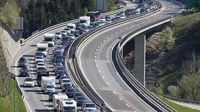As the Easter holidays approach, traffic congestion has become a familiar sight at the Gotthard Tunnel in Switzerland. On Wednesday, April 16, 2025, a significant seven-kilometer-long traffic jam formed on the north side of the tunnel due to an overload of vehicles, particularly between Amsteg and Göschenen in the canton of Uri. This situation, which is typical for the pre-Easter travel rush, caused delays of up to one hour and ten minutes, according to the Touring Club Schweiz (TCS).
The TCS, which is known for providing timely traffic updates, recommended an alternative route via the A13 and the San Bernardino Tunnel to help alleviate some of the congestion. Shortly before 5 p.m. on the same day, the traffic jam slightly decreased to six kilometers, resulting in a delay of almost one hour.
The Federal Roads Office has also warned that traffic jams and major disruptions are expected on the north-south axis starting from Wednesday and continuing into the Easter weekend. The TCS predicts 'very heavy traffic' at the Gotthard north portal for five consecutive days, making it essential for travelers to plan accordingly.
For those who may be unfamiliar, the Gotthard Tunnel has been a crucial transport route since its opening in September 1980, allowing travelers to access the sunny southern regions of Switzerland. The tunnel was first utilized during the Easter holidays in 1981, when vehicles queued for six kilometers heading south.
This year, the Easter travel rush is expected to peak on Maundy Thursday around noon, with significant traffic anticipated again on Easter Monday as holidaymakers return home. In recent years, the traffic jams at the Gotthard have become a tradition, often starting as early as Wednesday. The longest recorded traffic jam in recent years reached nine kilometers in both 2022 and 2024, while 2023 saw a maximum of six kilometers.
As travelers embark on their journeys, the TCS has been proactive in providing real-time updates. On Wednesday, April 16, 2025, at 4 p.m., the TCS reported a traffic jam of several kilometers via social media, indicating that vehicles were already lined up for seven kilometers, resulting in a time loss of around one hour and ten minutes.
Earlier in the day, at 2 p.m., the TCS had noted a five-kilometer traffic jam with a delay of approximately 50 minutes. The organization anticipates that traffic conditions will worsen on Wednesday and Thursday, coinciding with the start of spring breaks in seven cantons and one German federal state.
Travelers are advised to avoid peak travel times, particularly on Friday between 8 a.m. and 7 p.m., when the largest wave of travelers is expected. Those who can travel outside these hours may find a smoother journey through the Gotthard region. The TCS suggests that those looking to avoid long waits might consider starting their travels on the night of Maundy Thursday or waiting until Saturday.
As the situation develops, the TCS continues to monitor traffic conditions closely, providing updates and tips for navigating the congestion. For instance, on the evening of April 16, 2025, the traffic jam on the A2 heading south dissolved, but delays were still anticipated the following day.
With the Gotthard Pass road closed over the Easter holiday, travelers will need to rely on the tunnel and alternative routes. The TCS has emphasized the importance of staying informed about current conditions, encouraging travelers to check their website or social media for the latest updates.
In a time when many are eager to travel after a long winter, the Easter traffic jams at the Gotthard Tunnel serve as a reminder of the challenges that come with holiday travel. As people flock to the south for a break, the iconic tunnel remains a focal point of Swiss transportation, symbolizing both the beauty of the region and the logistical hurdles that can accompany popular travel times.
As the holiday weekend approaches, it’s clear that the Gotthard Tunnel will once again be at the center of significant travel activity. The TCS and the Federal Roads Office are preparing for the influx of vehicles, ensuring that travelers have the information they need to navigate the busy roads safely and efficiently.
Whether you're heading out for a short getaway or a longer holiday, planning ahead and staying updated on traffic conditions can make all the difference. With the right information, travelers can minimize their time spent in traffic and enjoy their time away from home.









